A Look At Global Mean Temperatures in 2013: Cooling Ahead!
By Fritz Vahrenholt, Frank Bosse
(Translated with permission by P Gosselin)
“Global Warming Is Taking A Break“ – that was the title of an article at the online Hamburger Abendblatt on 4 January 2013. And that’s hard to miss when you look at the latest global temperature chart:
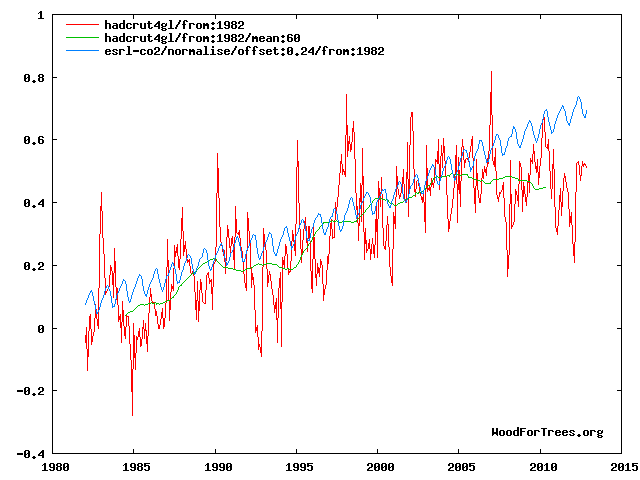
Red and green: temperature; blue: CO2.
This of course demands an explanation, which is provided by Jochem Marotzke, Director of the Max Planck Institute for Meteorology in Hamburg: It’s because of ocean currents, and this is indeed included in IPCC models. But something is wrong, and also Marotzke can’t get around it when he tried to explain the temperature stagnation in the interview with the Abendblatt:
“In such periods, the heat is taken in more strongly by the deep oceans. We still cannot explain why this is so.” Scientists have reason to suspect that heat is taken from the surface to the bottom in the southern oceans.“
The circulation in the world’s oceans is rather well known and how its function is not a mystery:
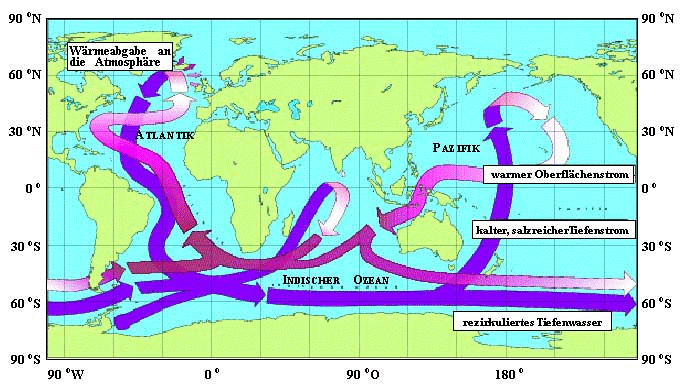
Source: Bildungsserver
We see a transport conveyor, and one region is especially distinct: the North Atlantic at 20-60°N and 10-60°W. Here we find the greatest heat release into the atmosphere. Wouldn’t this be the place to look in the search for the missing heat instead of suspecting mysterious, clandestine warm waters in the southern oceans? Let’s begin our search.
For an analysis we need data that accounts for the heat quantity at the lower depths of the sea. The IPCC models are often content with the upper 50 meters. But data have been collected down to 700 m already since 1955, and in recent times very precisely using automated bouys. What has been measured in the oceans 700 m can be found in the Ocean Heat Content (OHC) dataset. Here’s the development for the North Atlantic region:
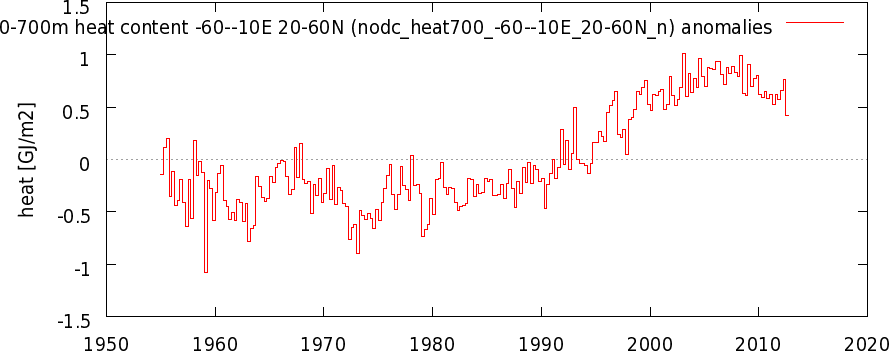
The diagram above shows the anomaly from the mean in Gigajoule per square meter. Does the shape of the curve look familiar? It certainly does! Its similarity to global temperatures is mind-boggling:
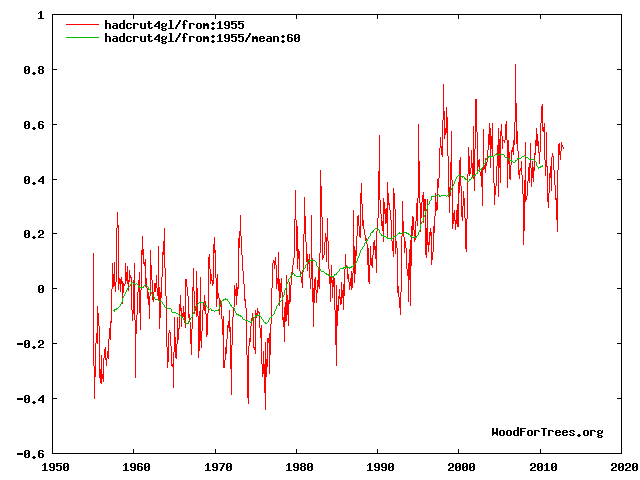
Source: woodfortrees.org
Just how similar are the curves? And does the similarity mean that the heat comes from the depths or vice versa: i.e. the atmosphere warms the water in rhythm? Here we carry out a correlation analysis to find out which is the hen and which is the egg. We want to know what comes first. Is it the heat content of the water mass, or the global temperature?

Just as we already suspected: correlation reaches a maximum with a lag of 12 months, with Ocean Heat Content (OHC) leading. This becomes even more distinct when the temperatures of the northern hemisphere (NH) are considered in place of global temperatures (global). Have we found a possible method of predicting global temperature 12 months out? For this a regression is carried out to determine the temperatures for the coming 12 months according to our model, which uses the current ocean heat values for the temperature prediction. And then we compare these temperatures with the real, measured temperature values.
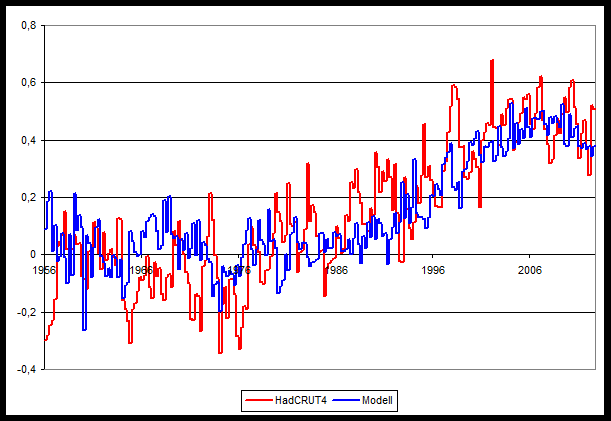
That doesn’t look bad at all, does it? We were able to project the course of the quarterly temperature series one year in advance with an accuracy of 57%. How does it do with the deviations? We do see some rather large ones, 1998 for example! We therefore depict the time series of the difference between the projected and real values, and at the same time change between El Nino and La Nina – the El Nino Southern Oscillation (ENSO) in the form of the Multivariate ENSO Index (MEI) series:
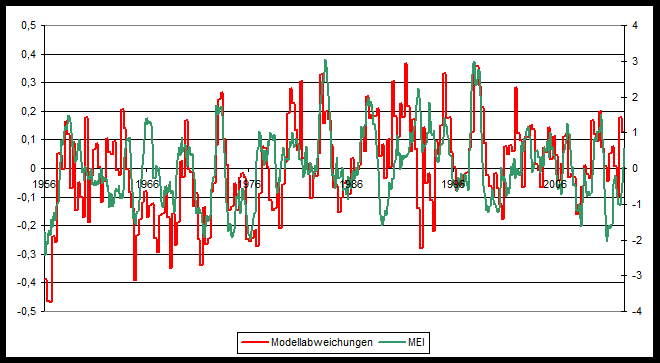
Here we see that many of the deviations can be well-explained by the ENSO (MEI). The heat amounts deep in the Atlantic also cannot be aware of surface volcanic eruptions. The negative deviations of 1992-1995 can be traced back to the eruptions. Thus we can make a prediction for 2013:
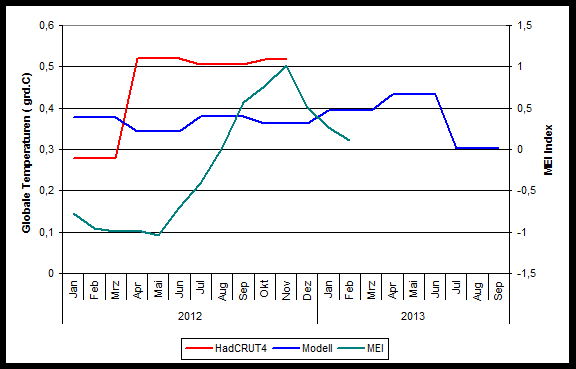
The red curve above depicts the quarterly global mean temperature. A higher resolution is not possible because the Ocean Heat Content (OHC) data is only available on a quarterly basis. We should not wonder that the first quarter of 2013 will be approx. one tenth of a degree C cooler than the previous months because the push by the last mini El Nino, which ended in fall 2012, is over. After a slight warming of a few hundredths of a degree in the second quarter of 2013, a tenth of a degree of cooling can be expected for the fall of 2013. This of course is only if no huge ENSO event occurs during the 2nd half of 2013. These impact the global temperature with a lag of about 4 months, which is why foresee the impact of the last ENSO until February 2013. How high is the probability for an El Nino in 2013? No one can say for sure, and so we will just have to wait and see for the second half of the year.
And then?
When the Ocean Heat Content of the North Atlantic has a period of approx. 65 years, then we can extend the curve above into the future, which would lead to values we saw in the 1990s!
The water of the lower depths is not sufficiently taken into account by the IPCC models. Should it indeed have an impact, as is indicated here, then it means that CO2 has a significantly lesser impact on the climate than we previously thought. It is likely that CO2 is only 50% of what the IPCC estimates when all natural factors and the impact of the sun are accounted for.
It’ll certainly be interesting to see how the months ahead shape up. We will see if our temperature prediction turns out to be right, and that without using any “mysterious”, heat transport somewhere down near Antarctica! So stop by at our Die kalte Sonne website as we will be keeping you up to date.
Our figures by the way are without any guarantee because there are weather variations and volcanic eruptions that cannot be foreseen…





Trenberth admitted, that AMO is NOT contained in the climate models, so Marotzke is lying. The Nature can easily push the global average up by 0,7deg C without any help of “humans” (see 1910-1940 period)
http://www.woodfortrees.org/plot/hadcrut4gl/from:1880/plot/esrl-co2/normalise
There is no difference between those two warming periods and there are two more cooling periods. Plus, UHI and all that CRU/NASA style data cooking has shifted the modern maximum above the 1940s maximum. In many places, those periods are almost identical temperature wise.
Multivalent The Multivariate ENSO Index (MEI) Captures . . . ”
~~~~~~~~~~~~~
“The water of the lower depths is not sufficiently taken into account by the IPCC models. Should it indeed have an impact, as is indicated here, then it means that CO2 has a significantly lesser impact on the climate than we previously thought.”
Who is “we”? Is this like the imperial WE of kings and popes (Gore, Hansen, etc.), or the authors of the paper? This presupposes that the meanings are an increasing amount of CO2 and “global warming” and not “climate” by itself. Water vapor and other active gases are important to Earth’s climates.
Next, the question of “heat transport somewhere down near Antarctica” seems to be not very useful. What actually is meant? The world map with very stylized and selected ocean currents is more confusing than helpful. My first question would be is the sinking water in the North Atlantic warm or is it cold? Salty warm water might be able to sink. Maybe it is salty cold water that sinks. But generally, I favor the notion accepted in the development of the Western Pacific Warm Pool that the warm water gets covered by less warm water that get blown (forced) over the top. The warm water stays there and does not sink.
~~~~~~~~~~
O/T Check out the developing Polar Outbreak in North America. Accu Weather is carrying a daily article.
Sorry, my beginning did not get copied on my end.
Here it is:
Multivalent ; should be Multivariate : May be just a German to English thing
Either way, the MEI is discussed by Bob Tisdale on 2010/09/11 with title beginning:
Thanks – fixed
ENSO has already gone negative.
http://www.bom.gov.au/climate/enso/monitoring/nino3_4.png
And previously the temperatures were only just barely above neutral into very weak El Nino territory. So we will not likely see a large amount of warming of the Pacific from the previous El Nino. From my reading of Tisdale, La Nina conditions allow a “charging up” of the Western Pacific Warm Pool. While surface temperatures are cooler, the ocean is building a net charge of energy. When the trade winds slacken or even reverse, that allows the warm water of the Warm Pool to spread back eastward where much of that energy is given up to the atmosphere so we see atmospheric warming but a net loss of energy from the top layer of water. If a La Nina condition follows, this warm water is then redistributed into the North Pacific when it is blown back westward.
In this case we saw only a very weak and brief El Nino condition that was not preceeded by a strong La Nina to “recharge” the warm pool to any great extent so I would expect to see a gradual overall cooling trend in the Pacific since the last significant El Nino of 2010. This is also why I don’t think that the most recent “stairstep” increase that Mr. Tisdale shows is going to hold. I believe it is going to fall back to where the trend was before the 2010 event.
funny how the millions of volcanoes on the sea bed spewing out lava at hundreds of degrees has no effect on the climate according to scientists, but fractions of a degree in warming has been taken to the depths of the ocean, hiding, ready to spring out on us and cause catastrophic armageddon in the future.
Asked:
Only if the air isn’t much hotter than the water, isn’t saturated and perfectly still. Try to warm up your bathwater by blowing hot air onto the top of the water with a hair dryer.
Vaporization occurs at any temperature above melting point. Some of the surface water will evaporate as long as the air above it isn’t saturated. When the water is frozen (ice) and the air warmer but still below freezing, the ice can go straight to gas (sublimation), without a liquid phase.
Water is also a poor conductor of heat.
So the molecules of liquid water at the surface would rather fly and be free than to stick around and pass onlong some warmth. There’s not a lot holding them back. vis pool “heating” example.
[…] https://notrickszone.com/2013/01/09/ocean-heat-content-based-model-by-german-scientists-shows-continu… […]
[…] science – and act before it is too late” The overwhelming empirical data shows the ocean currents and the Sun have a much greater impact on Climate Change than CO2. Moreover, acting […]